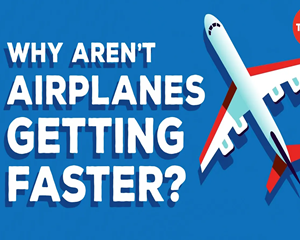In 1996, a British Airways plane flew from New York to London in a record-breaking two hours and 53 minutes.
在1996年,一架英国航空的航班破记录用时2小时53分钟从纽约抵达伦敦。
Today, however, passengers flying the same route can expect to spend no less than six hours in the air -- twice as long.
不过如今,乘坐同一航线的乘客至少要在空中花费6小时--记录时长的2倍。
So why, in a world where everything seems to be getting faster, have commercial flights lagged behind?
那么,为何当整个世界加快步伐时,商业航班是否已经落后?
The British-and-French-made Concorde began shuttling passengers across the sky in the 1970s.
在20世纪70年代,英法共同制造的协和式飞机开始运送乘客。
Jetting between destinations like New York, Paris, Bahrain, and Singapore, it clocked in at over 2,000 kilometers per hour, more than twice the speed of a normal airliner.
穿梭往返于纽约、巴黎、巴林和新加坡等目的地的该机型,能以2000公里的时速飞行,这是普通客机时速的2倍。
However this was also about 800 kilometers per hour faster than the speed of sound.
然而,由于这个时速比音速还要快上800公里。
And that created a surprising problem for people on the ground.
给地面上的居民带来了意料之外的困扰。
When an object moves at supersonic speed, it generates a continuous moving shockwave known as a sonic boom.
当物体以超音速移动,它会产生连续移动的冲击波,也就是所谓的“声震”。
This produces a loud, startling noise, as well as rattling windows and dislodging structural elements of buildings.
声震会发出巨大、吓人的噪音,同时造成窗户震动,使建筑物部件发生脱落。
Since a plane flying at an altitude of 15 kilometers can affect an area with an 80 kilometer diameter on the ground below,
一架飞在15千米高空的航班可以影响到下方直径为80公里内的地区,
complaints and concerns from residents in the Concorde's flight path restricted it to mostly ocean routes.
因此,遭到协和式飞机航线周边居民的控诉与忧虑,而将飞行限制在跨海洋航线。
Because of these restrictions and other fuel and engineering requirements, supersonic flights turned out to be very expensive for both airlines and passengers.
因为这些限制以及其它的燃料和技术需求,超音速飞行对航司和乘客而言就变得十分昂贵。
A single transatlantic round-trip could cost the equivalent of more than $10,000 today.
一次跨大西洋往返的费用相当于今天的1万美元。
With additional strain on the airline industry due to decreased demand for flights after September 11th, 2001, this became unsustainable, and the Concorde was retired in 2003.
自2001年911恐袭事件后,人们对航班需求的减少给航空业带来了额外的压力,高成本使其不可持续,协和式飞机也于2003年退役。
So even when superfast flights existed, they weren't standard commercial flights.
因此,即使有超高速航班存在,它们也不适用标准商用飞行。
And while we might think that advances in flight technology would make fast flights less expensive, this hasn't necessarily been the case.
同时,我们可能会想随着航空技术的进步提高飞行速度的成本会降低,事实却非如此。
One of the biggest concerns is fuel economy.
其中一个最大的担忧就是燃油经济性。

Over the decades, jet engines have become a lot more efficient, taking in more air and achieving more thrust -- traveling further for every liter of fuel.
过去几十年,喷气发动机变得更加高效,它们能吸收更多空气并获得更大的推动力--每升燃油支持的航程会增加。
But this efficiency is only achieved at speeds of up to around 900 kilometers per hour -- less than half the speed of the Concorde.
然而达到这一燃油效率的前提是保持时速900公里左右的飞行--协和式飞机时速的一半。
Going any faster would increase air intake and burn more fuel per kilometer flown.
再快就会增加进气量并在每公里的飞行中消耗更多的燃料。
A standard transatlantic flight still uses as much as 150,000 liters of fuel, amounting to over 20% of an airline's total expenses.
一次标准的跨大西洋航班仍要使用多达15万升燃料,占航空公司总支出的20%以上。
So any reduction in fuel economy and increase in speed would significantly increase both flight costs and environmental impact.
因此,任何燃油经济性的降低和速度的提高都会大大增加飞行成本和环境影响。
What about ways to make a plane faster without burning lots of fuel?
那有办法不消耗大量燃油使飞机飞得更快吗?
Adjusting the wing sweep, or the angle at which wings protrude from the fuselage, to bring the wings closer in can make an aircraft faster by reducing aerodynamic drag.
调整机翼的后掠角或机翼从机身延长出的角度,使机翼更接近,可以通过减少空气动力阻力使飞机更快。
But this means the wings must be longer to achieve the same wingspan, and that means more materials and more weight, which in turn means burning more fuel.
但这意味着机翼必须加长以达到相同翼展,意味着机翼需要更多材料,飞机会因此变重,结果还是要增加燃料。
So while airplanes could be designed to be more aerodynamic, this would make them more expensive.
所以,尽管飞机可以设计得更符合空气动力学,但这会增加成本。
And generally, airlines have found that customer demand for faster flights is not sufficient to cover these costs.
总体来说,航司发现乘客对于飞机提速的需求不足以弥补这些成本。
So while military aircraft conduct high speed flights over water and at high altitudes, supersonic commercial flights seemed like a brief and failed experiment.
所以,当军用飞机能在水上和高空进行高速飞行任务时,超音速商用飞机似乎就像一个短暂且失败的实验。
But recent advances may make them feasible again.
不过,近期的科学发展或许能让它们再次变为可能。
Research by NASA and DARPA has shown that modifying an aircraft's shape can reduce the impact of its sonic boom by 1/3.
美国航天局和国防高级研究计划局的研究表明改进飞机外形可以减少三分之一的声震影响。
Extending the nose with a long spike can break the shockwave into smaller ones,
一种方案是用长钉子延长机头将冲击波分解成更小的冲击波,
while another proposed design features two sets of wings producing waves that cancel each other out.
另一种拟议的设计则以两组机翼为特征产生冲击波,互相抵消。
And new technologies may solve the energy efficiency problem with alternative and synthetic fuels, or even hybrid-electric planes.
而新技术可以用替代和合成燃料,甚至是混合动力飞机,解决能源效率问题。
It may yet turn out that the last few decades of steady flying were just a brief rest stop.
事实可能证明,过去几十年的稳健飞行只是短暂的休息。













